STE Highlights, June 2022
Awards and Recognition
Awards and Recognition
Wang to serve on ANS division executive committee
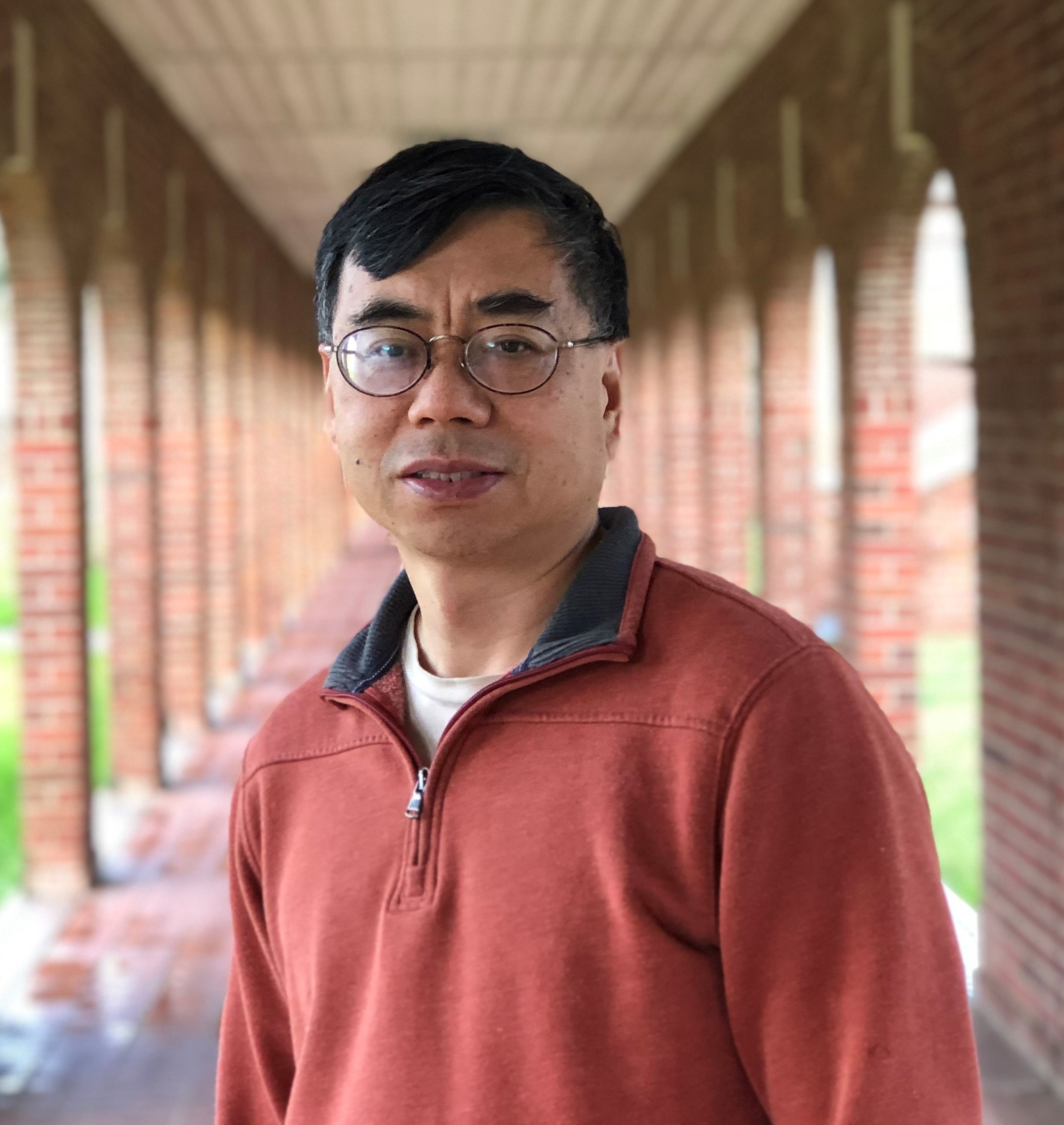
Yongqiang Wang
Yongqiang Wang (Materials Science in Radiation and Dynamics Extremes, MST-8) has been elected to the Executive Committee of the American Nuclear Society’s Accelerator Applications Division. His three-year term begins in June.
Wang is director of the Ion Beam Materials Laboratory (IBML) and team leader for the Radiation Science Experimental Team in MST-8. He is also a Center for Integrated Nanotechnologies scientist in its in situ characterization and nanomechanics thrust.
An expert in irradiation materials research with energetic ion beams through ion-solid interactions, Wang’s research interests include irradiation stability of nanostructured materials, radiation tolerant nuclear materials, graphene synthesis through ion implantation, and materials characterization using ion beam analysis techniques. He currently leads an effort to develop a number of IBML’s unique research capabilities to advance fundamental radiation science research in support of CINT users and the DOE Basic Energy Science program’s Energy Frontier Research Center, FUTURE, the Fundamental Understanding of Transport Under Reactor Extremes.
Wang also leads the development of applied research in support of nuclear energy and fusion materials research at the lab. Wang’s applied research areas include ion irradiation and corrosion experiments, in situ positron annihilation spectroscopy under ion irradiation, and coupled plasma exposure and dual ion beam irradiation extremes for fusion plasma face materials research.
He is an editor of the journal Nuclear Instruments and Methods in Physics Research: Beam Interactions with Materials and Atoms and serves on the editorial boards of the journal Materials and the Frontiers in Energy Research journal’s Nuclear Energy section. He is also a co-organizer of biennial, international Conference Series on Application of Accelerators in Research and Industry.
Wang earned his doctoral degree in nuclear physics and technology from Lanzhou University, China, and joined the Laboratory in 2003. Before joining the lab, he worked at University of Minnesota, the University of Louisiana at Lafayette and Missouri State University.
As a member of the Accelerator Applications Division (AAD) executive committee, Wang’s responsibilities include advising the AAD management team about the division-sponsored conferences such as the international accelerator applications conference and topical ANS student conferences; helping develop strategies in enhancing cooperation/interactions with other ANS divisions and recruiting new members to the AAD; and dealing with other emerging issues in the division.
The Accelerator Applications Division promotes the advancement of knowledge of the use of particle accelerator technologies for nuclear and other applications. It focuses on production of neutrons and other particles, and utilization of these particles for scientific or industrial purposes, such as the production or destruction of radionuclides significant to energy, medicine, defense or other endeavors, as well as imaging and diagnostics.
Tunes recognized for ion beam modification of materials accomplishments
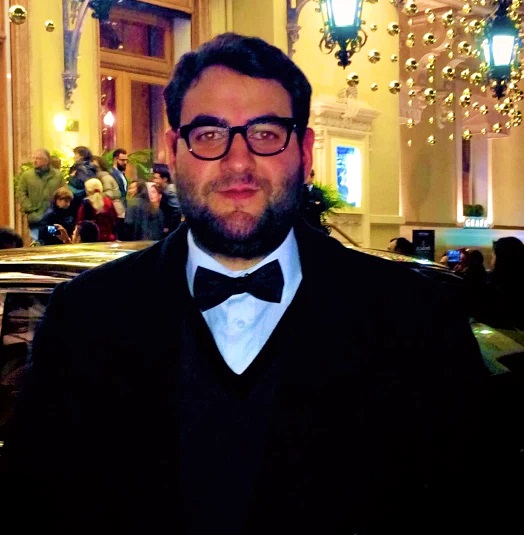
Matheus Tunes
Matheus Tunes (Materials Science in Radiation and Dynamics Extremes, MST-8) is the recipient of the IBMM Prize. The award, established in 2006 at the International Conference on Ion Beam Modification of Materials (IBMM), is awarded biennially to an early career researcher who has made an outstanding contribution to the field.
Tunes’s early-career accomplishments received strong support from his nominator and referees. He joined the Lab in 2021 as a Director’s Postdoctoral Fellow on the MST-8 Radiation Science (experimental) team. There Tunes performs research in the Hydride Research Laboratory on the development of novel ceramic materials for application in extreme environments.
Previously, Tunes was at the Montanuniverstität Leoben in Austria. He received his doctoral degree in atomic collisions in solids from the University of Huddersfield in 2020, where his research focused on in situ transmission electron microscopy ion irradiation of potential nuclear materials.
Tunes’ recognition marks a return of the IBMM Prize to Los Alamos. The inaugural prize of 2006 was awarded to Professor Lin Shao (Texas A&M University), at the time a Laboratory postdoctoral researcher at the Ion Beam Materials Laboratory.
Helping undergraduates develop science literacy

Eames Bennett
Postdoctoral researcher Eames Bennett (Nuclear and Particle Physics and Applications, P-3) recently served as an instructor in Bard College’s Citizen Science program. The Citizen Science program at Bard College, in New York, included 486 first-year student participants, with additional outreach to more than 2,000 K-12 students across six school districts.
During the intensive two-week program, students develop their personal science literacy through hands-on, real-world coursework and projects. The Citizen Science program provides a foundation for students, as citizens, to grapple with national and global issues that hinge on having a firm understanding of the underlying science. As an instructor, Bennett guided students through the program and taught sessions on data analysis and visualization, environmental contamination, and data ethics.
Bennett, who earned his doctoral degree in nuclear physics from Texas A&M University, joined Los Alamos National Laboratory in 2020 as a postdoctoral research associate to work on the Chi-Nu experiment at the Los Alamos Neutron Science Center. A member of the P-3 Low Energy Nuclear Physics Team, he studies the prompt fission neutron spectra of various actinides. He and Keegan Kelly (P-3) are working to develop a next-generation highly segmented dual neutron-gamma detector array to measure neutron scattering cross sections and angular distributions.
While at Texas A&M’s Cyclotron Institute, Bennett helped commission the TIARA for Texas detector array, made indirect measurements of astrophysically relevant nuclear reactions, and helped design and build a prototype novel penning trap for use at the TAMUTRAP facility.Chemistry
First plutonium sample via FIB-SEM achieved for the NNMA program
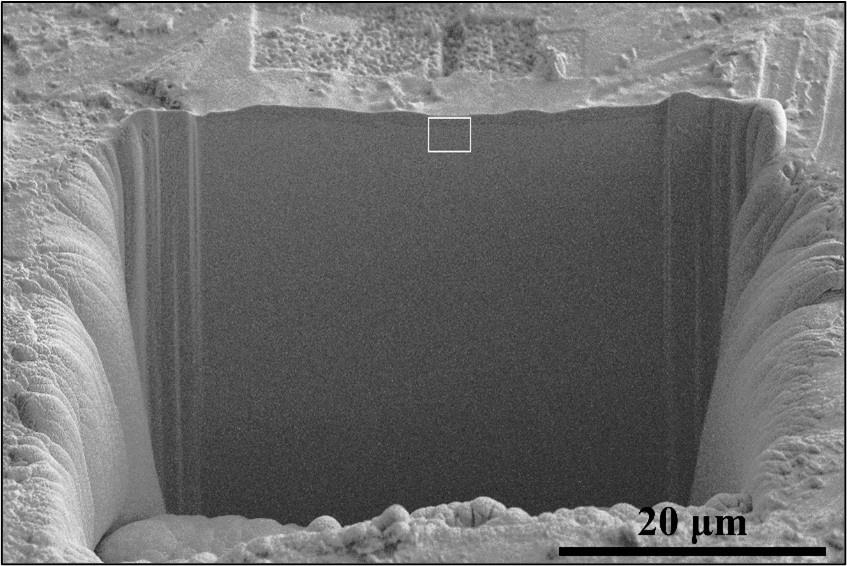
This low-magnification secondary electron image shows the cross-section prepared into the sample, with the inset box representing an area of higher magnification via a separate backscattered electron image.
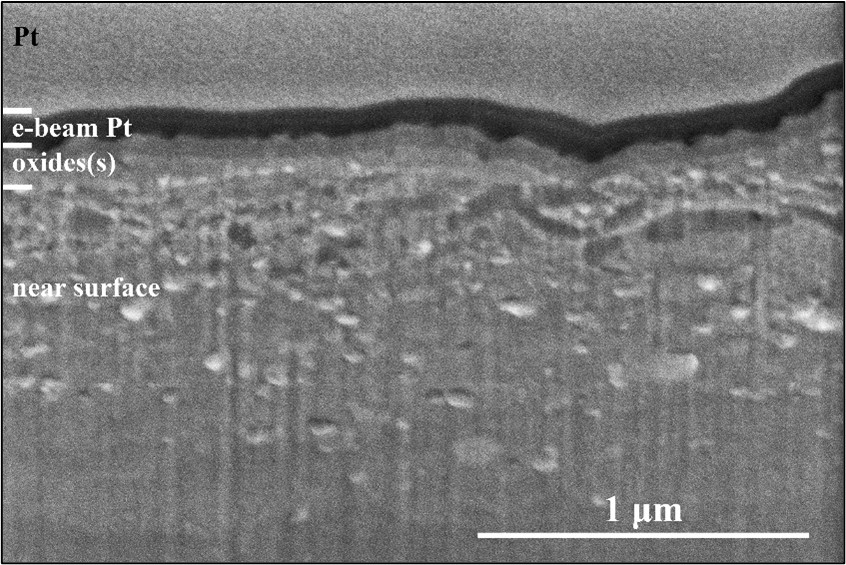
In this higher magnification backscattered electron image, platinum layers are deposited on the specimen in the instrument to protect the surface from the ion milling steps. The first layers under the Pt are oxide layers followed by the near-surface microstructure that is significantly different from the bulk structure.
Los Alamos National Laboratory recently installed its first dual-beam focused ion beam scanning electron microscope (FIB-SEM), providing an important characterization capability that has, until now, been missing from TA-55 capabilities.
Housed with the Nuclear Materials Science (MST-16) group, the instrument will be used in the characterization of plutonium (Pu). Members of the MST-16 group recently ran the first Pu sample through the system for the National Nuclear Materials Archive (NNMA) program within NA-83, the Office of Nuclear Forensics at the National Nuclear Security Administration. The NNMA program collects, analyzes and preserves representative samples of nuclear materials in support of nuclear forensic efforts.
Electron microscopes provide an unequaled ability to spatially correlate microstructure and chemistry from everyday technological levels down to the atomic scale. The FIB-SEM is a dual-beam instrument that combines a focused ion beam for sample microfabrication with an electron beam for structural and chemistry characterization. Elemental identification and quantification are based on the material-specific x-rays generated by electron beam-sample interactions.
This MST-16 instrument employs a gallium source for the ion column. The FIB-SEM enables point specific, three-dimensional characterizations of microstructures. The dual-beam instrument can be used interchangeably to identify areas of interest, prepare a cross-section into the sample, and immediately provide a characterization of the microstructure.
The instrument was purchased and installed through the Chemistry and Metallurgy Research Replacement Equipment Installation Phase 2 project at the Radiological Laboratory Utility Office Building, in support of the Laboratory’s Weapons programs.
Funding and Mission
The work was funded by Los Alamos National Laboratory, supporting the Global Security mission area and the Materials for the Future capability pillar.
Technical Contacts: Terry Holesinger and Anne Galyean
New additive manufacturing capability installed at C-CDE
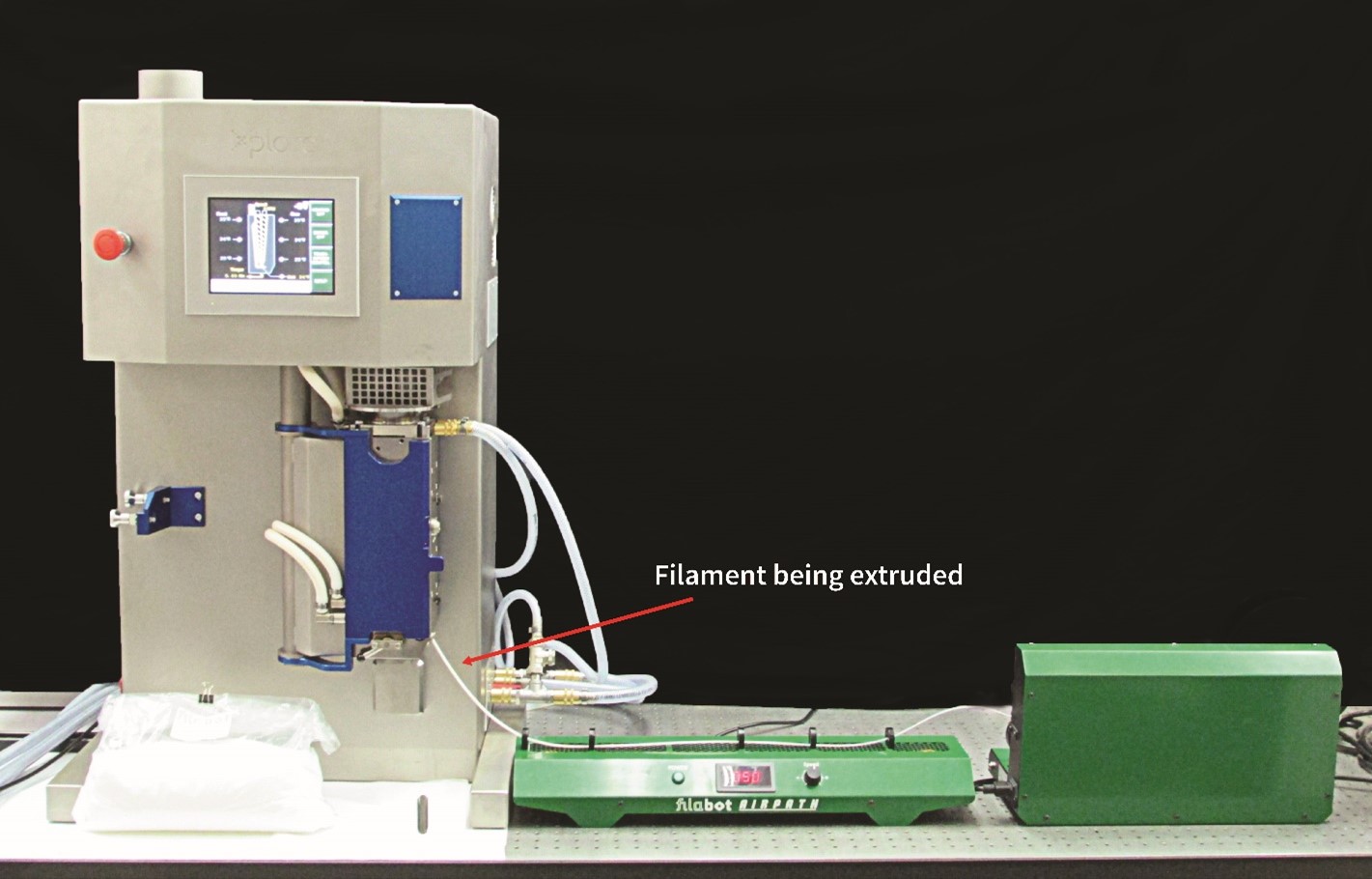
The micro-compounder, newly installed at TA-46, melts polymers and mixes in fillers of interest without the use of solvents.
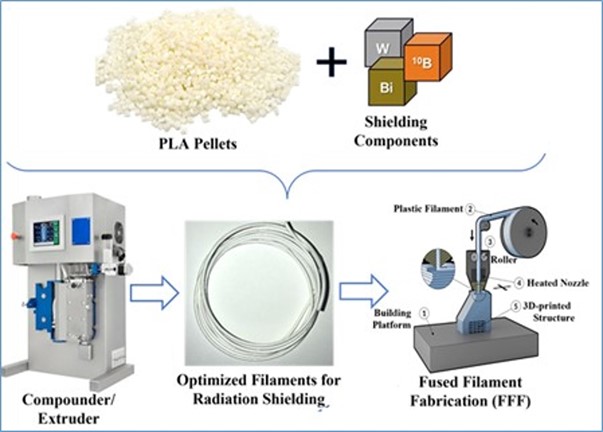
An example of mixing polylactic acid pellets with shielding elements, such as tungsten, bismuth and boron-10, to fabricate composite filaments to 3D print radiation-shielding materials.
The Chemical Diagnostics and Engineering group recently acquired and installed a micro-compounder at TA-46, expanding their capabilities to now include additive manufacturing. The micro-compounder allows the group to develop the advanced, complex filaments necessary for high-tech applications.
Additive manufacturing is a growing technology where objects are fabricated in a layer-by-layer fashion with the aim of increasing performance, quality and profitability while decreasing the amount of waste, development time and cost. One form of this technology is fused filament fabrication (FFF), which relies on heating thermoplastic filaments above their melting point or glass transition temperature and extruding the softened material through a nozzle onto a bed, where the filament slowly cools down enough to adhere to adjacent layers.
There are a multitude of commercially available FFF filaments, including acrylonitrile butadiene styrene, polylactic acid, polyethylene terephthalate and nylon. But more advanced filament compositions, necessary for high-tech applications, are much less common. Until recently, the C-CDE team relied on solvents to dissolve the polymer matrix and incorporate fillers, such as high-Z elements, to formulate novel multifunctional filaments.
The newly acquired micro-compounder has the advantage mixing polymers and fillers without the use of solvents. The micro-compounder allows for the quick development of complex filaments that combine multiple functional components — such as radiation shielding materials, antimicrobial ceramics, and acid/base indicators — into a single filament. As a result, objects 3D-printed with these unique filaments will exhibit properties exclusively designed for specific applications, such as use in extreme environments.
Funding and Mission
This work is supported by Los Alamos National Laboratory and supports the Global Security mission area and the Materials for the Future capability pillar.
Technical Contact: Andrea LabouriauMaterials Physics and Applications
New method developed for nanoscale materials characterization
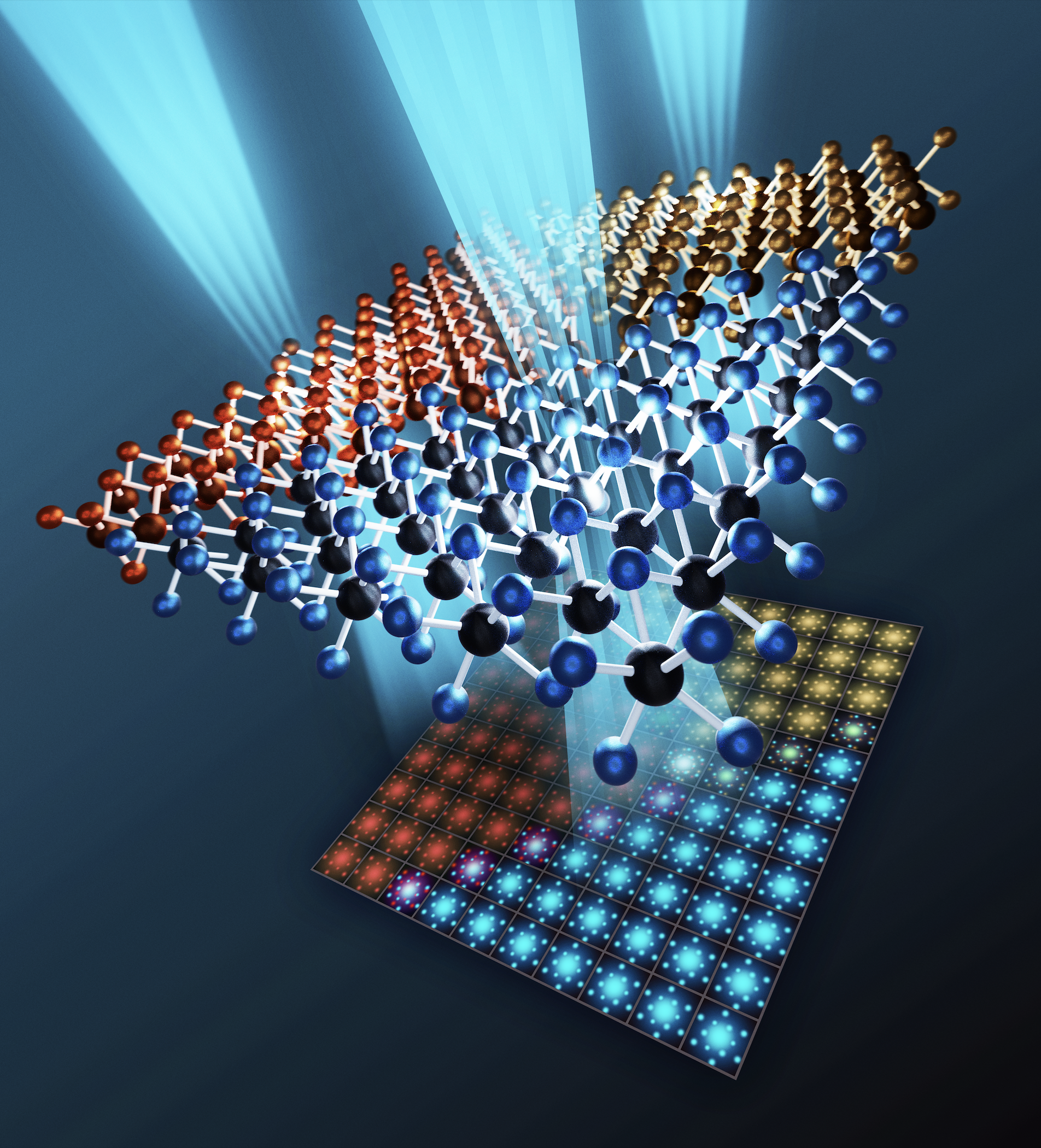
Shown is the electron scattering from the pristine surface of a continuous monolayer tungsten diselenide film. The 4D-STEM method provides for the analysis of statistically relevant information on grain size, orientation and lattice parameters without the sample’s physical or chemical alteration. (Image credit: Sarah Tasseff, Los Alamos National Laboratory)
In a recent cover article in the journal Nano Letters, a Los Alamos research team led by Michael Pettes (MPA-CINT) has developed a new method to obtain the local crystalline arrangement of solid materials and their imperfections from areas smaller than a nanometer. The method uses four-dimensional scanning transmission electron microscopy (4D-STEM), a materials characterization technique new to Los Alamos National Laboratory that was debated whether it would be sensitive enough to resolve this information. The approach fills an important void in the characterization of mission-relevant materials and can be used to fill in the local “messy” atomic length-scale regime information that other important characterization techniques, such as beam lines, fail to provide.
The 4D-STEM technique provides a method to visualize grains and grain boundaries in tungsten diselinide (WSe2) grown by metal organic chemical vapor deposition directly onto a glass substrate, silicon dioxide. The 4D-STEM technique can analyze statistically relevant information on grain size, orientation and lattice parameters without physical or chemical alteration of the sample, allowing for simultaneous strain and orientation mapping. The method is based on patterned-probe 4D-STEM and is the first demonstration of true transmission electron microscopy-based automated crystal orientation mapping at the nanoscale. The success of the new technique holds implications for significant follow-on impact in the field of nanoscale materials characterization.
Application-relevant, wafer-scale two-dimensional materials are usually polycrystalline. One of the major challenges in structural analysis resides in accurately identifying the grain boundary orientation and size distribution over a wide field of view, with enough spatial resolution to capture tens-of-nanometer sized domains. 4D-STEM now enables the fast collection of nano-beam electron diffraction patterns on a two-dimensional array of spatial positions. Various computational analyses can then reveal structural variations on a pixel-by-pixel basis over different scales while reducing knock-on damage in these traditionally hard-to-characterize samples.
Funding and mission
This work was supported by the Laboratory Directed Research and Development program and the National Security Education Center at Los Alamos National Laboratory. The work supports the Global Security mission area and the Materials for the Future capability pillar.
Reference
“Visualizing Grain Statistics in MOCVD WSe2 through Four-Dimensional Scanning Transmission Electron Microscopy,” Nano Letters 22, 6, 2578 (2022). DOI: 10.1021/acs.nanolett.1c04315. Authors: Alejandra Londoño-Calderon, Matthew Schneider, Yongqiang Wang, Enkeleda Dervishi, Jinkyoung Yoo, Michael T. Pettes (Los Alamos National Laboratory); Rohan Dhall, Colin Ophus (Lawrence Berkeley National Laboratory); Hee Seong Kang, Chul-Ho Lee (Korea University).
Technical Contact: Michael Pettes
Physics
New insights into nuclear matter probed in neutron stars
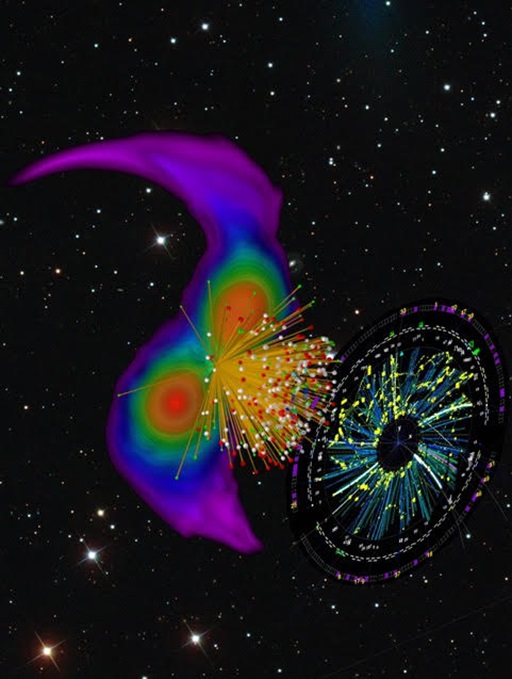
Artistic combination of a numerical-relativity binary neutron star merger simulation mimicking the properties of GW170817 (two non-spinning neutron stars with a chirp mass of 1.188 solar masses), of a heavy-ion collision (gold on gold nuclei impinging with a relativistic kinetic energy of 1.5 GeV per nucleon as simulated by the IQMD transport model), and of the detection picture of such an event in the FOPI detector at GSI Darmstadt, Germany. Credits: Tim Dietrich, Arnaud Le Fevre, Kees Huyser; background: ESA/Hubble, Sloan Digital Sky Survey
For the first time, an international research team, including researchers from Los Alamos National Laboratory, has combined data from nuclear physics experiments, gravitational wave measurements and other astronomical observations with theoretical insights to more precisely constrain the conditions of nuclear matter, as it can be found in the interior of neutron stars. The results were published in the scientific journal Nature.
Throughout the universe, neutron stars are born in supernova explosions that mark the end of the life of massive stars. Sometimes neutron stars are bound in binary systems and will eventually collide with each other. These high-energy, astrophysical phenomena feature such extreme conditions that they produce most of the heavy elements, such as silver and gold. Consequently, neutron stars and their collisions are unique laboratories to study the properties of matter at densities far beyond the densities inside atomic nuclei. Heavy-ion collision experiments conducted with particle accelerators are a complementary way to produce and probe matter at high densities and under extreme conditions.
Recent progress in multi-messenger astronomy allowed the international research team, involving researchers from Germany, the Netherlands, the United States and Sweden to gain new insights to the fundamental interactions at play in nuclear matter. In an interdisciplinary effort, the researchers included information obtained in heavy-ion collisions into a framework combining astronomical observations of electromagnetic signals, measurements of gravitational waves, and high-performance astrophysics computations with theoretical nuclear-physics calculations performed in the Theoretical Division at Los Alamos National Laboratory. Their systematic study combines all these individual disciplines for the first time.
The authors incorporated the information from gold-ion collision experiments performed at GSI in Darmstadt as well as at the Brookhaven National Laboratory and the Lawrence Berkeley National Laboratory in their multi-step procedure that analyzes constraints from nuclear theory and astrophysical observations, including neutron star mass measurements through radio observations, information from rapidly spinning neutron stars gained by NASA’s Neutron Star Interior Composition Explorer (NICER) mission on the International Space Station (ISS), and multi-messenger observations of binary neutron star mergers. Including data of heavy-ion collision in the analyses has enabled additional constraints in the density region where nuclear theory and astrophysical observations are less sensitive. This has helped to provide a more complete understanding of dense matter.
Funding and Mission
This work was supported by the Department of Energy, Office of Science, Office of Nuclear Physics, and the Office of Advanced Scientific Computing Research, as well as the Laboratory Directed Research and Development program. The work supports the Global Security mission area and the Nuclear and Particle Physics capability pillar.
Reference
“Constraining neutron-star matter with microscopic and macroscopic collisions,” Nature, 606, 276-280 (2022). DOI: 10.1038/s41586-022-04750-w. Authors: Ingo Tews (Los Alamos National Laboratory); Sabrina Huth, Achim Schwenk (Technical University of Darmstadt); Peter T. H. Pang, Chris Van Den Broeck (Nikhef); Tim Dietrich (University of Potsdam); Arnaud Le Fèvre, Wolfgang Trautmann (GSI Helmholtz Center for Heavy Ion Research); Kshitij Agarwal (Eberhard Karl University of Tübingen); Mattia Bulla (Stockholm University, AlbaNova); Michael W. Coughlin (University of Minnesota).
Technical Contact: Ingo Tews






